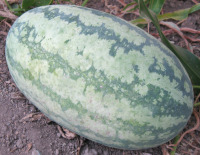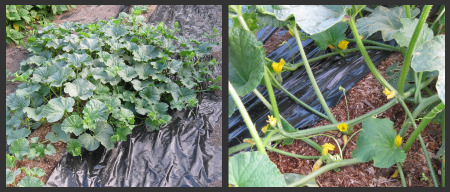|
Growing MelonsWatermelon & Cantaloupe
Help Growing Melons in Cool Climates Help Growing Melons in Cool Climates
Growing melons thrive in hot weather. If you live in a cooler climate, there are some things you can do to help your melons.
Back to Top 
Planting MelonsThere are hundreds of melons to choose from. We like to plant watermelon and cantaloupe. We have become fond of the French melon - Charentais. This melon is an heirloom variety that has a sweet distinctive flavor. Growing melons are sensitive to frost. These are some of the last seeds you’ll plant in your garden. If you’re going to plant your seeds straight into the garden, plant them about 5 days before the last frost-free date for your area. See
Vegetable Planting Guide. Plant the seeds 10-12 inches apart in a row. You can plant 5-6 melon seeds in a circle that’s about 18 inches in diameter. I prefer to use the row system because: the melons are easier to water, you don’t have to cut holes in the black plastic, and it gives the plants equal spacing to grow and spread. Sometimes I plant the seeds a little closer together and then thin the plants after they germinate. This way I don’t have open spaces when some of the seeds don’t germinate. If you spread a layer of manure or peat moss over the planted seeds, it'll help hold the moisture until the seeds have germinated and the plants are well established. Doing this reduces the number of times you need to water while the root system gets established. If you’re not going to use the black plastic, keep the growing melons weeded. See Garden Weeds. Cross PollinatingIf you’re saving seeds for next year’s planting you need to concern yourself with cross pollinating, but that’s another lesson. Seed to Seed teaches you how to saves seeds from one year to the next. Cucumbers will not cross-pollinate with squash/pumpkin or melons. Melons will not cross-pollinate with squash/pumpkin. The have their own family: melon family, squash & pumpkin family, and cucumber family. They only cross-pollinate within their own family. FertilizingAdd mulch or manure down the row along with 16-16-16 inorganic fertilizer and elemental sulfur. This is all tilled in the soil to a depth of 6 inches. Rake the soil smooth before planting. See Types of Soil. WateringPut your drip line in place before laying out your black plastic. You can also use a furrow system. An overhead sprinkler is not a good system to use. The growing melons are susceptible to fungus diseases, so it’s important to keep the leaves dry. See
Garden Watering Systems. Growing melons like to be watered deeply every 10 to 14 days. More damage is done by watering too much than by watering too little. Fungus and Pest ControlCucumber beetles and squash bugs are the two main insects that bother melon plants. Dust or spray the bugs with “sevin”. Make sure to get around the crown of the plant where squash bugs like to gather. Oft time powder mildew will develop on the leaves if you have too much moisture from the morning dew, rain, or overhead sprinkling. If this is a problem, you may have to spray with a fungicide. If you get a lot of rain or the soil that’s too wet, wire worms tend to infest the bottoms side of the ripening melons. If this starts happening, place a board or some other material under the melons to keep them off the soil. If you’re using black plastic, you won’t have this problem. Harvesting Watermelon and CantaloupeMelons taste better when they’re allowed to ripen on the vine. Harvesting Cantaloupe Most varieties of cantaloupe turn a yellow-tan when they’re ripe. The French melon (charentais) turns a grayish green. The stem will easily slip off the melon when it’s ripe. You don’t need to break it. Harvesting Watermelon There are a few different ways to check if a watermelon is ripe:
Back to Top Preserving MelonsOne of the challenges with growing melons is that they tend to ripen all at once. You have to eat fast. We enjoy making a frozen fruit cocktail to eat during the winter. The cocktail is made with a combination the following fruits: grapes, watermelon, cantaloupe, nectarines, peaches, plums, strawberries, raspberries, and blackberries. Take the fruit cocktail out of the freezer about 10- 15 minutes before you’re going to eat it, this way it’s stays slightly frozen and crunchy. Return to Growing Fruit from Growing Melons |
























